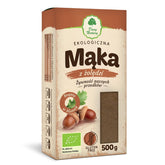Bulgur groats – properties and preparation methods
Contents
Along with rice, bulgur grain is an essential part of the Middle Eastern diet. It has been known and appreciated there for almost 4,000 years. It is used to prepare a traditional Middle Eastern dish called pilaf. In Poland, bulgur has enjoyed relatively recent popularity. The trend for it arose with the growing interest in healthy eating.
Bulgur is made from durum wheat—the most valuable wheat variety, also used to make semolina and couscous. However, bulgur groats contain at least twice as much fiber and are definitely lower in calories. When making bulgur, the wheat grains are specially prepared and then subjected to a milling process. This results in three types: coarse-grained, medium-grained, and fine-grained. Let's take a look at the properties of this delicious, slightly nutty porridge and how best to prepare it.
Nutritional properties of bulgur groats
Bulgur, regularly included in our diet, can have a positive impact on our health. It contains many valuable nutrients that support the proper functioning of the body and naturally protect us from the development of certain diseases. Bulgur is a source of:
- Magnesium,
- Potassium,
- Sodium,
- Iron,
- Calcium,
- Fiber,
- B vitamins , including folic acid.
Magnesium helps lower blood pressure and dilate arteries, thus preventing constipation. It has a relaxing effect on the body. Potassium supports the proper functioning of the heart and reduces the risk of heart attack. On the other hand, B vitamins support the nervous system and, in combination with magnesium, promote concentration and memory. The fiber contained in groats improves the functioning of the digestive system: it prevents constipation, regulates the digestive process, and accelerates metabolism. Due to all these properties, bulgur groats are especially recommended for people:
- live in constant tension and stress,
- are struggling with cardiovascular problems,
- follow a weight-loss diet,
- Pregnant,
- during great mental exertion, during studies and exams,
- Diabetic.
Bulgur has a low glycemic index, so it's safe for diabetics to consume. Due to its gluten content, it's not recommended for people with gluten intolerance or celiac disease.
How do you eat bulgur?
Bulgur groats are great for salads, meat dishes, and soups. However, the most traditional dish made with bulgur groats is pilaf—a filling dish made with groats, vegetables, and meat, in this case poultry (it can also be pork or lamb). To prepare it, you will need:
- Chicken breast fillets - about 0.5 kg,
- Onion,
- Garlic - a few cloves,
- Chicken broth - one glass,
- Bulgur groats - 300 g ,
- can of tomatoes,
- a handful of raisins,
- a handful of pine nuts,
- Saffron, cumin, dried chili, salt and pepper – spices to taste,
- Oil or olive oil for frying.
In a heated pan with a little olive oil or oil, add the finely chopped onion and garlic, followed by the diced chicken fillets. After a few minutes, add the broth with a teaspoon of saffron to the meat. When it boils, add the remaining spices, raisins, and nuts. Mix everything thoroughly and simmer over low heat for about 5 minutes. After this time, add the canned tomatoes and a little water and simmer for another 20 minutes. Meanwhile, prepare the porridge according to the package instructions. Pour the vegetable and meat sauce over the finished porridge. Sprinkle with parsley or cilantro to finish.
THE PUBLISHER'S CHOICE
Dried plums 1 kg BIOGO
- £6.08
- £6.08
- Unit price
- / per
Dried White Mulberries 500 g ORGANIC
- £5.07
- £5.07
- Unit price
- / per
Almonds 1 kg BIOGO
- £10.15
- £10.15
- Unit price
- / per
Cranberries sweetened with apple juice organic 1 kg BIOGO
- £14.21
- £14.21
- Unit price
- / per
Dried dates 1 kg BIOGO
- £3.65
- £3.65
- Unit price
- / per
Unpeeled buckwheat groats 1 kg BIOGO
- £2.44
- £2.44
- Unit price
- / per
Walnuts 800 g BIOGO
- £7.51
- £7.51
- Unit price
- / per
Peeled sunflower seeds 1 kg BIOGO
- £2.64
- £2.64
- Unit price
- / per
PULLED ORGANIC SUNFLOWER SEEDS 1 KG BIOGO
- £3.85
- £3.85
- Unit price
- / per












































































































































